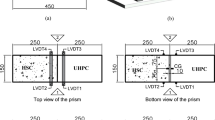Abstract
The use of tropical hardwoods in structural applications requires knowledge of the mechanical properties. Even though long experience is available with the species azobé (Lophira alata), much of the current knowledge is based on tests performed on small clear specimens for bending, compression and shear. Since tropical hardwoods are used in structures with high economic value, a sound knowledge of the mechanical properties allows for better optimisation and for minimal use of raw material. Bending, compression and shear tests have been performed on material in structural sizes. Characteristic values show that in most loading cases the structural capacity of the material is distinctly higher than currently assumed in practice. The relationship between static modulus of elasticity and bending strength has been determined. The depth effect was shown to be less pronounced than for softwoods.
Zusammenfassung
Der Einsatz von Konstruktionsholz aus tropischen Hölzern setzt die Kenntnis der mechanischen Eigenschaften dieser Hölzer voraus. Obwohl Bongossi seit vielen Jahren als Bauholz vor allem in bewitterten Konstruktionen verwendet wird, wurden mechanische Kennwerte für Biege-, Druck- und Scherbeanspruchung vor allem aus der Prüfung kleiner fehlerfreier Prüfkörper abgeleitet. Da tropische Hölzer überwiegend in ökonomisch bedeutenden Konstruktionen eingesetzt werden, erlaubt eine bessere Kenntnis der mechanischen Eigenschaften optimierte Konstruktionen sowie Einsparungen insbesondere beim Rohstoff. In dieser Arbeit wurden Biege-, Druck- und Scherversuche mit Prüfkörpern in Bauholzabmessungen ausgewertet und die entsprechenden charakteristischen Steifigkeits- und Festigkeitskennwerte bestimmt. Die Ergebnisse zeigen, dass Bongossi bessere mechanische Eigenschaften aufweist als bisher angenommen. Die Beziehung zwischen statischem Elastizitätsmodul und Biegefestigkeit wurde bestimmt. Der Höheneinfluss von Bongossi zeigte sich weniger ausgeprägt als für Nadelholz.








Similar content being viewed by others
References
Barrett JD, Griffin H (1989) Size effects for Canadian dimension lumber, CIB-W18 Timber Structures, Paper 22-6-1, Berlin, German Democratic Republic, September
Barrett JD, Lau W (1989) Moisture content adjustments for in-grade data, CIB-W18 Timber Structures, Paper 22-6-2, Berlin, German Democratic Republic, September
Barrett JD, Fewell AR (1990) Size factors for the bending and tension strength of structural timber, CIB-W18 Timber Structures, Paper 23-10-3, Lisbon, Portugal, September
Benjamin JR, Cornell AC (1971) Probability statistics and decision for civil engineers. McGraw-Hill
Blass HJ, Gard WF (1994) Machine strength grading of timber, Pacific Timber Engineering Conference, vol 2. Gold Coast, Australia, pp 598–603
Bohannan W (1966) Effect of size on bending strength of wood beams. US Forest Products Laboratory, Bulletin No. 56
NIST (2001) Dataplot. National Institute of Standards and Technology, USA
Eurocode 5 (2002) Design of timber structures, Draft version
European Standard EN 338. Structural timber—strength classes
European Standard EN 384. Structural timber—determination of characteristic values of mechanical properties and density
European Standard EN 1193. Timber structures—structural timber and glued laminated timber—determination of shear strength and mechanical properties perpendicular to the grain
European Standard EN 1912. Structural timber—strength classes—assignment of visual grades and species
Frühwald E, Thelandersson S (2001) Nordic wood: reliability of timber structures, Reliability analysis, COST Action E24 Reliability Analysis of Timber Structures, Copenhagen Meeting, 19–20 October 2001
Fewell AR, Curry WJ (1983) Depth factor adjustments in the determination of characteristic bending stresses for visually graded timber. Structural Engineer, vol 61B, No.2
Fewell AR, Glos P (1988) The determination of characteristic strength values for stress grades of structural timber. Part 1. CIB-W18 Timber Structures, Paper 21-6-2, Parksville, Canada
Houtinstituut TNO (1961) Buig- en drukproeven bij azobé van handelskwaliteit en afmetingen en bijbehorend klein foutvrij hout (in Dutch). Report H-61-78
Houtinstituut TNO (1977) Sterkte eigenschappen van gebruikt en ongebruikt azobé (in Dutch). Report H-77-93
ISO 2394 (1998) General principles on reliability for structures
Leicester DE, Breitinger HO (1992) Measurement of shear strength. In: IUFRO S5.02 Proceedings, Nancy
NEN 5480, Quality requirements for timber—Species Azobé
Rammer DR, McLean DI (1996) Recent research on the shear strength of wood beams. In: Proceedings of the international wood engineering conference, vol 2, New Orleans, pp 96–103, 28–31 October 1996
Ranta-Maunus A (2001) Summary report on existing strength data. COST Action E24 Reliability Analysis of Timber Structures, Copenhagen Meeting, 19–20 October 2001
Schickhofer G (2001) Determination of shear strength values for GLT using visual and machine graded spruce laminations CIB W18 Timber Structures, Paper 34-12-6, Venice
Van der Linden MLR, Van de Kuilen JWG, Stolle P, Katsma H (1996) Full scale testing of timber sheet pile walls. World timber engineering conference, vol III, New Orleans, pp 557–564
Van Douwen AA, Kuipers J, Loof HW (1958) Corrections to the mean value and the standard deviation from test series with symmetrical test specimens, Stevin laboratory report. 4-82-9/oe-5, Delft University of Technology
Weibull W (1939) A statistical theory of the strength of materials, Royal Swedish Institute for Engineering Research. In: Proceedings N. 141:45
Wood Handbook (1999) Forest Products Laboratory, Madison
Author information
Authors and Affiliations
Corresponding author
Rights and permissions
About this article
Cite this article
van de Kuilen, J.W.G., Blass, H.J. Mechanical properties of azobé (Lophira alata). Holz Roh Werkst 63, 1–10 (2005). https://doi.org/10.1007/s00107-004-0533-7
Published:
Issue Date:
DOI: https://doi.org/10.1007/s00107-004-0533-7




